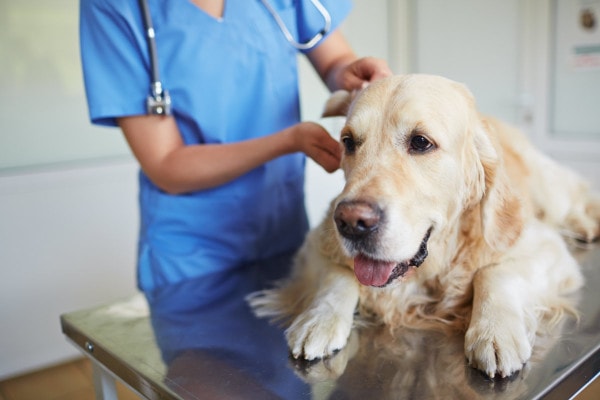Figuring out when to take a dog to the emergency vet can sometimes be stressful. That’s why integrative veterinarian Dr. Julie Buzby asked Dr. Kathryn Williams to create this useful reference guide. In it, Dr. Williams, an emergency vet, shares when to take your dog to the emergency vet and when your dog’s situation can probably wait until regular office hours.

As a devoted pet owner, it is normal to worry about your dog or cat and want the best care for him or her. Sometimes you may find yourself in a situation where you know your dog is sick, but you aren’t sure if your dog needs immediate attention.
If you are having trouble deciding if your dog’s situation is an emergency or can wait until an appointment with your primary vet, I hope to offer some guidance from my years of experience as an emergency vet.
However, keep in mind that this is by no means an exhaustive list and the line between an emergency and not an emergency can be blurry sometimes. So if you are still worried about your dog, please call your vet or nearest emergency veterinary clinic so they can help guide you further.
If there is any doubt, it is best to err on the side of caution and seek medical attention for your dog sooner rather than later.
How urgently should I take my dog to the vet?
When thinking about conditions that require veterinary attention, I tend to like to break the situations into three categories—those that require immediate attention, those that require attention within a few days, and those where you should schedule an non-urgent appointment with your primary care vet.
10 life-threatening situations where you need to take your dog to the emergency vet ASAP
The following are life-threatening conditions in dogs, and mean you should seek medical attention immediately:
1. Difficulty breathing is an emergency
Your dog breathing fast or struggling to breathe may be a sign of:
- Pneumonia in dogs
- Heart failure in dogs from heart disease in dogs
- Fluid in the chest cavity (i.e. pleural effusion)
- Respiratory crisis from laryngeal paralysis in dogs or collapsed trachea in dogs
- Other respiratory or heart conditions
Signs that your dog is having difficulty breathing and needs to go to the ER include:
- Increased resting respiratory rate (>50 breaths/minute when not panting)
- Blue or purple tint to the gums
- Extending the neck to breathe
- Using extra abdominal effort to breathe
- Abnormally loud or high-pitched breathing
2. Bloated abdomen can be an emergency
A pot-bellied dog appearance (i.e. enlarged or bloated abdomen) can be a sign of life-threatening conditions like:
- Internal bleeding due to a tumor (e.g. a ruptured splenic mass in dogs)
- Heart failure
- Gastric dilation and volvulus (i.e. bloat in dogs)

However, there are also some conditions such as Cushing’s disease in dogs which can cause gradual abdominal enlargement but are not immediately life-threatening.
3. Weakness, significant limping, trouble walking, or paralysis is an emergency
A dog who is wobbly and off balance, a dog’s back legs collapsing, any incoordination, altered mental state, trouble standing, severe limping, and/or continued seizures in dogs all call for a trip to the emergency vet clinic.
While far from an exhaustive list, these symptoms could indicate:
- Spinal stroke in dogs (i.e. fibrocartilaginous embolism or FCE)
- IVDD in dogs
- Brain tumor
- Shock (due to blood loss, trauma, allergic reactions, etc.)
4. Frequent or non-productive vomiting is an emergency
Throwing up multiple times in one day or trying to vomit without producing any bile or vomitus are highly concerning for potentially life-threatening conditions such as:
- Bloat
- Intestinal blockage
- Severe pancreatitis in dogs
Therefore, it is best to take your dog to the pet emergency room if you notice continued or non-productive vomiting.
5. Trauma is an emergency
Any sort of significant trauma, including bite wounds, cuts and wounds that continue to bleed, a dog being hit by car, snake bite on a dog, etc. warrant an emergency room visit.
6. Ingesting or being exposed to a toxin is an emergency
If your dog gets into a toxin or something that you think might be toxic, please call ASPCA Animal Poison Control Center or Pet Poison Helpline first. (Be advised these toxicology services do charge a fee, but it is well worth it.)

The toxicology specialists will advise you if your dog needs to be seen by the emergency vet. Plus, the information the toxicologists provide will help the emergency team determine the best way to proceed. With toxicology cases, the vet may need to induce vomiting to try to remove as much of the toxin as possible and/or provide continued care.
Common toxicity situations in dogs include:
- Grape or raisin toxicity in dogs
- Xylitol toxicity in dogs
- Chocolate toxicity in dogs
- Ingesting medications intended for other pets or humans in the house
- Getting into rat bait
- Antifreeze toxicity in pets
7. Hives (i.e. allergic reactions) is an emergency
If you see signs of an allergic reaction in a dog such as sudden hives, facial swelling, vomiting, and collapse, head to an emergency animal hospital. Just as anaphylactic shock can be dangerous in people, it can be life threatening in dogs as well.
8. Heat stroke is an emergency
Heat stroke in dogs constitutes a life-threatening emergency and can develop quickly. Some of the symptoms include:
- Sudden collapse
- Excessive panting
- Stumbling
- Disorientation
- Red, pale, or bluish gums
- Severely elevated body temperature
(For more information, check out my blog post on heat stroke vs heat exhaustion in dogs.)
Brachycephalic dogs (i.e. short nosed dogs) or dogs with underlying respiratory issues are most at risk. I have seen heat stroke in a Bulldog when it was only 70° F outside. Therefore, it is important to know how to keep a dog cool in summer and how to cool down a dog, especially if you have a dog who is at high risk of becoming an overheated dog.
9. Sudden changes in eye appearance or sudden blindness is an emergency
Eye issues that require immediate veterinary attention include:
- Sudden blindness
- Trauma to the eye (e.g. protrusion of the eye, scratch or puncture from a cat nail or thorn, etc.)
- Squinting the eye or holding it closed (which often indicates eye pain)
- Cloudy eyes in dogs
Eyes can go bad fast, so it is important to get your dog to the vet quickly for an accurate diagnosis if you notice eye issues.
10. Dystocia (i.e. trouble giving birth) is an emergency
Thankfully, delivering puppies does not always constitute an emergency. However, if you see any of the following signs, seek veterinary attention immediately. The life of the puppies could be in danger, and medical intervention is necessary.
- 30 to 60 minutes of strong contractions without a puppy
- Over four hours between puppies when you know there are more inside
- When over 24 hours passes after the mother’s temperature drops and she does not go into labor
- Extreme signs of pain
- Over 70 days of gestation (i.e. pregnancy)

Certain breeds are more prone to having difficult births (especially Bulldogs). So a preplanned C-section with your regular vet may be the safest option for those dogs.
Situations where your dog needs to see a vet within a couple of days
Sometimes, there are situations that aren’t truly an emergency. But they do mean your dog needs to see a vet within a few days. Some examples include:
- Vomiting (once or twice) and/or the dog having diarrhea but acting fine (if not resolving with supportive care)
- Coughing (if still behaving normally, normal respiratory effort)—dogs with kennel cough for example
- Dog limping—this can be a tricky one. If there is a broken bone, exposed bone, your dog cannot bear weight on the leg, or he or she is dragging one or more legs, this constitutes an emergency. However, if your dog is able to bear weight on his or her leg, but is a little more tentative than normal, this can likely wait for an appointment with your veterinarian.
- Decreased appetite that lasts more than 24 hours
- Changes in urination or more frequent accidents in the house (e.g. signs of a UTI in dogs)
- Worms in feces
- Dog ripped a nail off (if not painful or continuing to bleed)
Situations where it is best to make an appointment with your primary care vet (not to go to the emergency vet)
There may also be situations where your dog is stable enough to wait for an appointment, and seeing your regular vet (or a specialist) can better serve your dog’s needs. Some situations where this may be the case include:
1. Fleas and ticks
Many emergency clinics do not carry preventatives to manage flea or tick infestations. However, your primary veterinarian is well equipped to advise you on appropriate prevention for your dog.
2. Skin infections or ear infections
Chronic allergies are often the underlying cause for skin infections (e.g. pyoderma in dogs or dog paw yeast infections) and ear infections (i.e. otitis in dogs). While the local emergency clinic may have some skin and ear medications on hand, your primary veterinarian likely has a wider range of medications, shampoos, and preventatives to not only manage the infection, but also the underlying condition.
3. Chronic conditions
Unless your dog has taken a sudden turn for the worse, routine management of chronic conditions, such as glucose curves for diabetes in dogs and monitoring blood work for chronic kidney failure in dogs, are best performed by your primary veterinarian. Your vet knows your dog’s medical history well, which makes him or her best equipped to make changes to medication, diet, etc.
However, if your dog suddenly gets sick and has a chronic condition such as diabetes, liver disease in dogs, or kidney disease, that does constitute an emergency. And your dog should be seen as quickly as possible.

4. Tumors or masses
Unless a tumor or mass has suddenly ruptured and the bleeding is uncontrollable, these typically are chronic conditions. Thus, they are best served with diagnostics and surgery with your primary veterinarian or a surgeon.
5. Cases that need a second opinion
Naturally, a diagnosis of a chronic or life-threatening condition is alarming. And it is important to do your due diligence if you feel the diagnosis is incorrect or want more information about what is going on with your dog.
However, if your dog is stable, it would be best to seek a second opinion with a veterinary specialist near you (e.g. internist, oncologist, cardiologist, etc.) rather than heading to the emergency room. A specialist has the ability and tools to work up a case more thoroughly than is possible in the ER setting.
A bit of preparation goes a long way
Emergencies can happen when we least expect them, but there are some actions you can take to be as prepared as possible:
- Know how to take your dog’s vital signs and what constitutes normal
- Perform a weekly 5-minute dog wellness scan to make it easier to identify normal vs. abnormal and to help you tell when your dog is sick
- Make or buy a dog first aid kit and know how to use each item in it
- Review what to expect during an emergency vet visit
When in doubt, head to or call the emergency vet
Remember, if you are concerned about your dog’s health, it is always better to err on the side of caution. There’s a mantra in emergency medicine, “If you’re concerned, we’re concerned.” As emergency vets, we are happy to help you and your dog feel better as quickly as possible. And we are only a phone call or a visit away.
Disclaimer: The advice provided in this post is intended for informational purposes only. It does not constitute medical advice regarding pets. If you are concerned about your pet’s condition, please call your vet and note the advice they give you, or head to the nearest emergency clinic.
Why have you needed to take your dog to the emergency vet?
Please comment below.


My 15 year old dog, a black and white rat terrier, named Tank, had been diagnosed with pancreatitis. His liver enzymes had been elevated. He had been vomiting at home like every other day for about a week so we took him in. They couldn’t do an x-ray or an ultrasound because he wouldn’t cooperate. All they did was send him home with Entice to put on his meals, special diet food, syringes to give him for better appetite, cause he wasn’t eating well. Then gave him opioids bupherine..
I called the doctor and told him he was sleeping most of the day, and wouldn’t take the syringe for the appetite control.
Why wasn’t my dog prescribed antibiotics if he had pancreatitis? This was on a Saturday.
Monday I called my vet explained the whole situation. He went in the next day, Tuesday and he had jaundice in his eyes, ears, and belly.
And told me his liver was shutting down.
We put him down. Said our last good -byes.
Did the Dr. fail by not putting my dog on medications.. All he received was pain meds, appetite stimulant, entice for his food. And something on the back of his head that dispersed fluids..
I felt that he was not cared for properly having being diagnosed with pancreatitis and elevated liver enzymes.
Dear Carol,
I am so sorry for the loss of your beloved boy. I understand your grief and the urge to try and find answers for how things progressed. It is normal to ponder all the “what ifs” but unfortunately sometimes we end up with more questions than answers. Some dogs with pancreatitis respond very well to supportive care or treatment at home, while others need to be hospitalized for very intensive management. Also, pancreatitis can cause a dog’s condition to deteriorate quickly, with little to no warning, and it can end up being fatal despite our best efforts. Since I was not personally involved in this situation it is hard to make assumptions on why certain choices were made. I will say that antibiotics are not a mainstay of treatment for this condition as it is caused by inflammation and bacteria is usually not the culprit. I am not sure if hospitalization was offered or even an option at the Emergency facility you visited. Many ER facilities will do triage and start treatment but will ask for the patient to be transferred back to the regular vet for continued treatment and monitoring. There are specialty hospitals that offer an ICU but not all areas have one of these available. Again, I am so sorry for your loss of Tank. I hope with time your heart will heal and you will be comforted knowing he lived a long and happy life. May his memory be with you always and bring you joy. ♥
My baby girl has ACL (slip knee in both rear legs) is one reason I take her. I am so grateful for your help and support with our babies because many times you have helped me through a lot of hard times with her. I did what you said and called her veterinarian about the bleeding and he put her on gabapentin 100mg and stopped the other one and she is doing better now. That caprit( it’s like motrin) had caused her to bleed bad. If you were here I would give you a GREAT big hug and kiss on the face for being there for us. Thank you for your blog and emails for different issues. You’re a beautiful woman and a blessing.
Hi Cheryl,
I am so glad you were able to get your girl’s medications switched and she is doing better. Thank you for the update and for all the kind words. You have definitely put a smile on my face today! Best wishes to you and your pup. Bless you. ♥
My dog has stage 5 heart murmur and we have had to take her to a cardio specialty vet for regular monitoring and medication adjustments. Her main symptoms were passing out episodes and labored breathing. However, we have gotten two extra years with her so far with her being treated medically. She is now 15. I adopt Sr. dogs. 🙂
Hi Diane,
I am so glad to hear that your girl is doing well despite the heart issues she is dealing with. What a blessing you have gained so much extra quality time together. Thank you for sharing your experience with us. Bless you both and keep up the good work!
Excellent article ! Thank you!